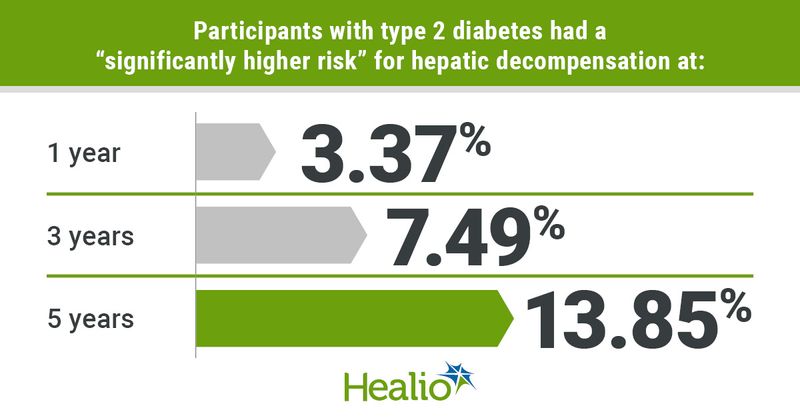Type 2 diabetes heightens risk for hepatic decompensation, HCC in patients with NAFLD
Key takeaways:
- At 5 years, patients with type 2 diabetes had higher risk for hepatic decompensation (13.85% vs. 3.95%).
- Risk for hepatocellular carcinoma at 5 years also was higher among those with diabetes (3.68% vs. 0.44%).
Type 2 diabetes was an independent predictor of hepatic decompensation and development of hepatocellular carcinoma among patients with nonalcoholic fatty liver disease, according to data.
“Previous studies have shown that type 2 diabetes is associated with hepatic decompensation among people with cirrhosis, hepatitis C virus and heavy alcohol consumption,” Daniel Q. Huang, MBBS, a visiting scholar at the NAFLD Research Center at the University of California, San Diego, and colleagues wrote in The Lancet Gastroenterology & Hepatology. “However, the risk of hepatic decompensation (development of ascites, hepatic encephalopathy or variceal bleeding) among individuals with NAFLD with and without type 2 diabetes has not been systematically assessed.”

In a meta-analysis of participant data from six studies, Huang and colleagues investigated the association between type 2 diabetes and liver-related outcomes among 2,016 participants (mean age, 57.8 years; BMI 31.3 kg/m2, 53.3% women) who underwent magnetic resonance elastography between February 2007 and June 2021.
At baseline, researchers noted 736 participants had type 2 diabetes, 114 had hepatic decompensation and 47 had HCC. The presence of type 2 diabetes was associated with hepatic decompensation at baseline (OR = 2.95; 95% CI, 2-4.36), a finding that remained consistent after multivariable analysis (adjusted OR = 3.08; 95% CI, 1.98-4.78).
In a longitudinal assessment of 1,737 participants (602 with type 2 diabetes) without hepatic decompensation at baseline, 105 developed hepatic decompensation over a median follow-up of 2.8 years.
Participants with type 2 diabetes had a “significantly higher risk” for hepatic decompensation at 1 year (3.37%; 95% CI 2.1-5.11 vs. 1.07%; 95% CI, 0.57-1.86), 3 years (7.49%; 95% CI. 5.36-10.08 vs. 2.92%; 95% CI, 1.92-4.25) and 5 years (13.85%; 95% CI, 10.43-17.75 vs. 3.95%; 95% CI, 2.67-5.6) compared with those who did not have diabetes. After adjusting for age, BMI, and race or ethnicity, type 2 diabetes (subdistribution HR = 2.15; 95% CI, 1.39-3.34) and HbA1c (sHR = 1.31; 95% CI, 1.1-1.55) remained independent predictors of incident hepatic decompensation.
Over a median of 2.9 years, 22 of 1,802 participants who did not have HCC at baseline developed incident HCC, with a higher risk in those with type 2 diabetes at 1 year (1.34%; 95% CI, 0.64-2.54 vs. 0.09%; 95% CI, 0.01-0.5), 3 years (2.44%; 95% CI, 1.36-4.05 vs. 0.21%; 95% CI, 0.04-0.73) and 5 years (3.68%; 95% CI, 2.18-5.77 vs. 0.44%; 95% CI, 0.11-1.33). Type 2 diabetes independently predicted the development of HCC (sHR = 5.34; 95% CI, 1.67-17.09).
“People with type 2 diabetes have a significantly higher risk of hepatic decompensation and hepatocellular carcinoma than people without type 2 diabetes,” Huang and colleagues concluded. “Suboptimal glycemic control is associated with a higher risk of hepatic decompensation and hepatocellular carcinoma. The higher risk of hepatic decompensation and hepatocellular carcinoma in people with type 2 diabetes should be considered when designing clinical trials in NAFLD.”
They continued: “These data serve as a call to action to prevent type 2 diabetes and reduce the growing burden of NAFLD and NAFLD-related hepatocellular carcinoma.”
Editor’s Note: Although NAFLD has been recently updated to MAFLD, we are keeping it as is in this article because the study was conducted prior to the official update to the name.
